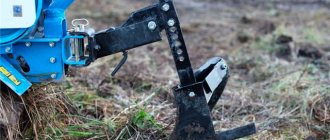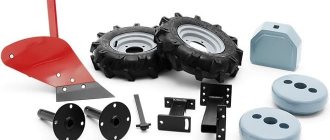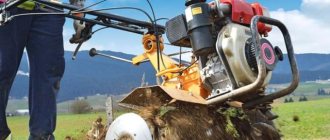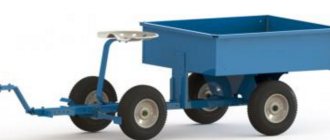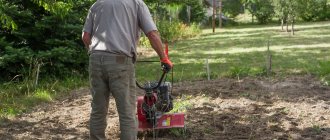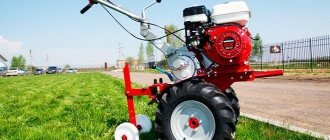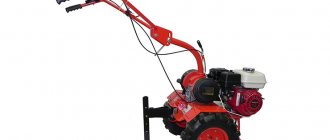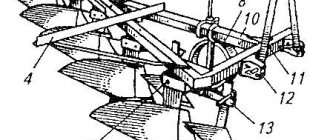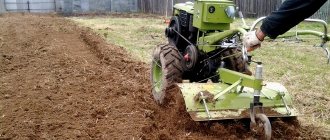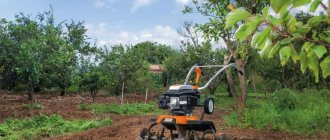Huggies Diapers Elite Soft 8-14 kg (size 4) 66 pcs
1099 ₽ More details
Huggies Diapers Elite Soft 5-9 kg (size 3) 80 pcs
1099 ₽ More details
Headlights
For owners of gardens and vegetable gardens, plowing the land is one of the most important agricultural works. If in the old days they used the services of tracked or wheeled tractors, or the digging was carried out independently with a shovel, today they have been replaced by modern agricultural machinery. And the most popular among such equipment are walk-behind tractors. They do not consume a lot of fuel, take up little space, and have very reasonable prices. Plowing with a walk-behind tractor today is commonplace for many summer residents and farmers.
This unit does not consume a lot of fuel
Plowing the site
It’s not difficult to figure out how to plow with a walk-behind tractor and a plow.
To do this, you need to roll out the device to the place where the land is plowed and along the first row, where loosening will take place, pull a cord that you can use to guide it - the plow pulls to the right, and it is quite difficult to make the first row level without auxiliary means. The handle of the equipment should be turned to the left in order to walk across an area of land that has not yet been plowed. Before starting the main plowing, it is necessary to carry out control plowing of the soil - walking to the opposite end of the site at low speed.
This is necessary to check whether the tiller is adjusted correctly and whether the furrow depth is sufficient (it should be 15–20 cm). We place the right lug in the row-crop furrow, engage first gear, tilt the device to the right and begin to move.
Having completed the first control pass, we turn the device 180 ° so that the right wheel of the walk-behind tractor is on the opposite side to the already plowed row, and move in the opposite direction. After the second pass, we evaluate the depth of the furrow. If the depth is not sufficient or the furrow is too deep, the plow must be adjusted again.
When plowing the area, you need to make sure that the right lug does not extend beyond the furrow and that the plow stand is perpendicular to the surface of the ground. The ridge of each subsequent furrow should not be far from the previous one (the distance between the ridges is up to 10 cm).
It is also important to ensure that the furrow does not lie on top of the previous furrow as a heap of earth. To do this, the right wheel must move in the middle
If you figure out how to properly plow a plow on a walk-behind tractor and correctly adjust it, then the device should move smoothly, without jerking or pulling to the side.
Over time, when you are sure that the furrows are even, the speed can be increased so that the surface of the earth is level and the plowing itself goes faster.
You need to plow the soil with a walk-behind tractor slowly, you cannot push the device. If the engine overheats, which often happens, plowing must be stopped for a while.
Did you know? The fertile layer (humus) cannot be restored. As a result of plowing, the oxygen level in the deep layers of the soil increases, causing humus to mineralize. This is the reason that in the first years, plowed soils produce large yields. However, it is the process of mineralization of the fertile layer that leads to a reduction in its quantity, which can have bad consequences for humanity.
Thus, we found out that it is better to use medium and heavy walk-behind tractors for hanging a plow and plowing the ground with it. The plow is attached to the minitractor using hitches, after which it must be adjusted (depth, handle, plowing plane level). Correct adjustment is the key to effective plowing. When plowing the area, you need to monitor the depth of the furrows, the engine temperature, and the position of the walk-behind tractor wheels.
Preparatory activities
We’ll talk about how to plow the ground with a walk-behind tractor a little lower. First, let's find out what other preparatory activities, in addition to hanging the wheels and plow, need to be done.
Before starting the operation of loosening the soil, it is worth stretching an orientation cord along the first row of the plot. Experienced plowmen may well skip this step. Beginners should definitely perform this operation. The fact is that during the plowing process, any plow moves slightly to the right. And therefore it is very difficult to make a row perfectly even. The cord will help you not to deviate from the “course”.
Starting from the second, all rows can be done without the use of additional guides, since the wheel of the walk-behind tractor will follow the furrow.
What attachments does the walk-behind tractor work with?
Any experienced farmer knows that with the help of a walk-behind tractor, cultivator or other motorized equipment, almost all agricultural work can be mechanized, from cultivating the land to prepare it for sowing and ending with transporting the harvested crop. Motor units have become universal due to the possibility of using a variety of attachments. For example, for cultivating plowed land and cultivating virgin lands, not only moldboard and other plows were created, but also:
- harrows;
- hillers;
- rotary cutters;
- flat cutters-weeders.
Harrows are used to plow virgin soil, as well as for pre-sowing or post-harvest loosening of arable soil to a depth of 7-14 cm. Using harrowing with a walk-behind tractor or cultivator, the surface is leveled, moisture is covered, and weeds are destroyed. The working parts of such agricultural implements are metal teeth or spherical disks. In this video you can clearly see how to properly plow with a walk-behind tractor and a homemade harrow.
Using a hiller, you can hill up potatoes, cut furrows for sowing seeds, fill in planting material, and also sprinkle weeds directly in the area of the rows. Hilling devices come in single-row and double-row, with fixed and adjustable working widths, distinguishable both by their design and their efficiency. Here is a video of how the Neva MB2 walk-behind tractor performs processing with a mounted two-row hiller-weeder.
With a rotary cutter you can plow virgin soil, carry out pre-sowing and basic cultivation of plowed land. This agricultural implement allows you to mill, cultivate the land and qualitatively prepare it for sowing. It is capable of not only plowing the soil, but also crumbling large layers, mixing with fertilizer, crushing stubble particles, and leveling the sown area. Rotators for plowing come in different types, depending on the number of cutting elements. This video shows how to actually plow a walk-behind tractor with a cutter installed on it.
A flat weeding cutter helps to trim weeds, split and cut grooves without turning the formation, plow and crush the soil. Flat cutters come in all possible working widths and processing depths, which allows you to choose them for specific processing conditions of agricultural plots and crops. This video shows how to carry out processing with a mounted flat cutter in practice using the example of a Dnepr walk-behind tractor.
In addition to the listed removable tools designed to plow virgin soil and cultivate arable land, rakes, wood splitters, seeders, shredders, cultivators, rotary and segment mowers, shovels, sprayers, sweeping brushes, snow blowers, etc. are used with the motorized unit. Having a basic set of mounted agricultural implements, you can use a walk-behind tractor or a powerful cultivator to perform all kinds of economic tasks, in particular, pre-sowing plowing, sowing and planting crops, applying fertilizers, inter-row cultivation of crops, harvesting root crops, and seasonal harvesting of green fodder.
How to assemble wheels on a walk-behind tractor at home
It is impossible to create pneumatic or cast models on your own (without the use of special equipment). And in principle, there is no point in doing this, because car wheels can be used to equip the chassis - Zhiguli wheels or Niva tires can easily be installed on a walk-behind tractor.
At home, lugs are most often collected. Factory models are expensive, so purchasing them for processing small areas is unprofitable. The way out of the situation is to make it yourself. All you need is a rim from old car wheels, metal plates, bolts and patience. The algorithm for assembling lugs is as follows:
- Old car wheels of the required diameter are selected based on the power of the walk-behind tractor, since the weight of the finished structure will be impressive (it is made entirely of metal).
- Plates are welded along the entire outer radius of the rim. In order to increase the strength of the structure, they can be additionally secured with bolts.
- Teeth are welded to the metal plates. They are made from angle steel, which is pre-cut into pieces of the required length. There should be a distance between the teeth of at least 15–20 cm.
- Axle shafts are welded into the disk, the structure is supplemented with bearings and mounted on the chassis of the walk-behind tractor.
The teeth ensure reliable wheel grip on clay soil when working in all weather conditions. To reduce slipping and simplify control of equipment in difficult operating conditions by increasing the missing mass of the unit, weights are attached to the outside of the lugs (on the inside of the wheels or on the walk-behind tractor bracket) using hub bolts. By using this attachment, the weighting is increased by 20%.
One of the frequent questions after purchasing a walk-behind tractor was the choice of iron wheels for working with the ground (lugs).
At first glance, you may be a little confused by the large assortment that stores offer. It's actually quite simple.
The main parameters of iron wheels are width, height and number of runners.
The two main tasks that iron wheels on a walk-behind tractor help solve are plowing (working with a plow) and cutting ridges with subsequent hilling. Let's look at the wheels of these tasks:
1. Working with a plow.
Everything is simple here. The wider the wheel and the further it is from the center of the walk-behind tractor, the more steadily the walk-behind tractor and plow will move.
Important points.
a) The height of the wheel affects the speed of movement. You should not take wheels higher than 500mm to work with a plow. For plowing, do not take wheels lower than 420mm, because... at a smaller diameter there is a high probability of the soil being caught by the walk-behind tractor gearbox.
b) For better traction with the soil, take three-slide lugs. light soil will pass through the runners until the toe catches hard soil and pushes off to move forward.
On single-slide or rubber wheels, slipping often occurs as soil quickly gets packed between the teeth.
2. Working with the hiller.
a) To work with one hiller, which cuts ridges or hills them, choose single-wheel wheels, the diameter of which allows them to be installed under the wing of the walk-behind tractor. Most often, their outer diameter should not exceed 425mm and width 130mm.
The wheel must be installed without adapters on the gearbox shaft of the walk-behind tractor and occupy the smallest possible track. If the soil is heavy (clay/loam) and the lugs slip in it, I recommend weighing down the front part of the walk-behind tractor with a weight.
On such wheels, the row spacing will be slightly greater than or equal to the track width of the walk-behind tractor on these wheels.
On most walk-behind tractors, the original rubber wheels, which are placed directly on the gearbox, do a good job.
b) To work with a two-row hiller, you need to take high wheels from 500 to 600 mm. In the rut, each wheel will move along the hiller. It's comfortable. Two hillers rigidly fixed to the frame make parallel ridges, and, as you know, it is much easier to build a third with two parallel straight lines.
Working with such a hiller is advisable when the vegetable garden is at least 10 acres (namely a vegetable garden, not a plot).
Important point.
If you have a heavy walk-behind tractor with a power take-off shaft (MTZ, MotorSich, Ghepard, Grillo, etc.), then the entire choice will come down to the only possible lugs 600x130 mm. They are suitable for single-row hilling or double-row cutting of ridges and, frankly speaking, are of little use. The walk-behind tractors already come with good heavy rubber wheels that have the same dimensions.
A multifunctional walk-behind tractor can perform a wide range of work in the field, cottage and garden. In order to quickly and efficiently process arable land and virgin soil, various types of attachments are used together with the device. The most common and best tillage unit is the share plow. Instructions on how to prepare it for work and plow it correctly are described in our article.
Walk-behind tractor for plowing land
Experienced farmers are well aware of how important it is to carry out high-quality cultivation of the land before planting, as well as in the fall. Yield largely depends on this
If earlier you had to spend whole days on such work, now you can use a walk-behind tractor that will cope with the task in an hour. When choosing a high-quality and productive device, you can process in two hours the area that would take a whole day with manual plowing.
When choosing an assistant to work on the farm, many people wonder whether it is possible to cultivate the land with a Neva walk-behind tractor or another model, or whether a walk-behind cultivator is better. In fact, there are no significant differences between these types of technology. Many farmers use both one and the second name to refer to conventional walk-behind tractors.
Purpose of the cutter
When working with this tool on a cultivator, you can plow the land efficiently. In addition, it is an excellent assistant in the fight against weeds, which can significantly reduce the upcoming harvest. The milling cutter allows you to achieve different soil structures and obtain clods of soil of the required size.
It is one of the most important elements of the cultivator and is responsible for the following functions:
- quality of soil cultivation;
- condition of the cultivator transmission;
- comfort ergonomics of unit control;
- stability of the power plant.
Proper plowing of the land with a walk-behind tractor
Before plowing, wheels with a diameter of 50−60 cm and a width of 18−20 cm are hung
It is important to comply with these parameters; if the wheels are too narrow, there is a possibility that the tool will swing from side to side. An insufficiently large diameter will create a small distance between the soil and the gearbox
If the rim is solid, the likelihood of soil collecting in the lug ribs increases.
You will need a partner to hang the equipment. It will help to lift the equipment and place it on stands, to a recommended height of 15-20 cm. In this case, the edge of the ploughshare should touch the ground. The plow stand is positioned vertically, and the beam is installed in a horizontal position. The right edge is installed in line with the inner edge of the right wheel. This ensures even cutting of the soil, easy falling off and smooth running of the walk-behind tractor. Before carrying out operations, you should consult the manufacturer's instructions.
Soil preparation
A cord is stretched along the ground, which serves as a guide for further movement. It is usually installed on the first row. These rules help inexperienced plowmen maintain a landmark, since the plow leads to the side. On the second row the cord is removed. As a rule, a person who has already done similar types of work has no problems maintaining the required distances and making all the rows even.
Working with land
After preliminary preparation, plowing begins. For fewer unnecessary movements, the walk-behind tractor goes along the side that is larger. This allows you to make fewer turns, which saves both the worker’s effort and the time spent redefining the direction of the block. Handle swivels to the left for ease of movement on unplowed ground
It is important to maintain a moderate pace of movement of the block to prevent the motor from heating up. In case of overheating, operation is suspended until the unit cools down
It is also not recommended to push the plow.
Each field is unique and has different soil hardness. The normal quality of the soil is looseness, in which the soil can easily be pierced with a metal stick to a depth of 50 cm. Hard soil makes it difficult for the plowing machine to move and negatively affects the serviceability and further performance of the tool. In this case, the soil is moistened with ordinary water or special solutions, and the plot is passed through twice. The first is preparatory, and the second is used for plowing to full depth. In some cases, you should consolidate the result and go through it a third time.
Basic criteria for choosing quick-release chassis elements
So, what wheels are best to buy for a walk-behind tractor? The criteria for selecting quick-release elements are as follows:
- type (pneumatic - for working on normal soil, cast - for processing virgin soil, metal with lugs - to improve maneuverability in clayey or too wet areas);
- diameter. The size of universal chamber-type models that can be installed on walk-behind tractors of all brands is 4–10 inches. With heavy equipment, tube wheels with metal rims with a radius of 6–12 inches are used. Additionally, they are equipped with extension cords and fasteners. Such chassis elements allow not only to process large areas, but also to transport cargo. It is not worth equipping heavy units with low pressure tires. The wheel size should be selected based on the purpose of operating the equipment. For example, wide models (with a diameter of at least 40 cm and a width of 20 cm) are well suited for plowing soil and digging up potatoes. To treat the sown crop against weeds, choose a narrower wheelbase so as not to damage the plants when driving;
- availability of extension cords. Such elements are included in the set of wheels used to equip equipment operating in difficult areas. Extensions are available in a wide range of sizes - from 20 to 37.5 cm. The main task of this device is to increase the maneuverability of the unit.
Advantages and disadvantages of mechanical plowing of the site
It is quite clear that during the operation of technical devices, energy and time are significantly saved, so the level of productivity of workers in the agronomic industry increases literally several times. It is also very encouraging that along with plowing the garden with a walk-behind tractor, you can carry out other useful procedures, such as loosening the soil or adding useful substances and fertilizers to the soil. Another advantage of using technological development is the uniformity of tillage, improvement of soil condition and its saturation with oxygen. During the cultivation process, there is a decrease in the number of weeds and harmful insects, because during plowing, pests are “thrown out” to the surface, where they become prey for birds. As evidenced by the results of numerous studies, after cultivating the land with a walk-behind tractor, the soil demonstrates the highest yields. With all this, there are some not particularly pleasant features associated with this procedure. We are talking about contraindications for plowing an area with weeds and those that have a deep root system. Constant cultivation is also a kind of stress for the soil, so it is necessary to periodically “feed” it with fertilizers and other things.
Features of work
Attachments make it possible to expand the scope of application of the Salyut walk-behind tractor. You can effectively carry out absolutely all the work typical of rural areas. Undoubtedly, before starting work you will have to thoroughly understand the instructions, because the effectiveness of the equipment is, first of all, the correct settings and adjustments.
Rotary plow
Using a rotary plow, which has left and right multi-directional plows in its design, you can plow in forward and reverse directions. For the most effective work, it is better to choose a model with a plow adjustment, that is, the ability to adjust the cutting depth and tilt angle.
Plow installation:
- depress the pedal;
- fix the stand;
- after that the entire structure is rotated 90°.
Zykov's plow
Zykov's plow is significantly different in appearance from other models. The video review clearly shows that its main differences are carefully selected angles and a completely different profile of the plow-mold surface, which makes it possible to better paint the soil and turn over the layer. Such plowing almost completely eliminates weeds.
Here is a review of plowing with a Zykov reverse plow on a Salyut walk-behind tractor
Double sided plow
A double-sided plow (hiller) is used for hilling agricultural crops and destroying weeds. This device is used to cultivate the soil and cut a furrow for planting plants. Subsequent backfilling is done by turning on the walk-behind tractor in reverse. The units are distinguished with variable and constant working width.
A device with a non-adjustable width works in conjunction with a lightweight walk-behind tractor; 12 mm racks reliably protect it from overload. The most widespread are hillers with variable widths that can be adjusted. Such plows work perfectly in combination with Salyut 5DK walk-behind tractors. However, they have one drawback - the soil crumbles after passing.
Dutch hiller
Less known is the Dutch hiller, which forms narrow wedge-shaped furrows due to the movement of its wings not only to the sides, but also upwards. The formed bed ensures better contact of the planting material with the soil. Structurally simple, easy to manufacture, cheaper in cost.
Disc dipper
The disc hiller is much more productive, but its price is 3-4 times higher than usual. However, according to reviews, owners do not return to their previous devices after working with a disk hiller.
The Salyut walk-behind tractor with a Japanese engine is the most successful choice of agricultural equipment in terms of a combination of proven quality and reasonable price.
Recommendations
To ensure that working with a walk-behind tractor is easy and soil cultivation is effective, you must follow a number of simple recommendations.
- It is better to cultivate plots up to 6 acres in size using cultivators. But if you decide to use a walk-behind tractor, then instead of a plow you should use saber-shaped or claw cutters.
- It is recommended to use a mounted plow when plowing fields larger than 1 hectare. However, it is also better to process the edges of areas and places with complex geometry using cutters.
- During operation, it is necessary to carefully monitor the condition of the equipment and prevent oil leakage from the transmission. Otherwise, harmful liquid will enter the treated soil and cause partial contamination.
- When plowing virgin lands, as well as when cultivating rocky and clayey soils, it is necessary to use weighting agents. Otherwise, there is a high risk that the walk-behind tractor will start jumping on the virgin soil and deep plowing will require a lot of effort.
- When using cutters, it is recommended to equip their ends with protective discs. This will reduce the likelihood of cultivating adjacent lands and will allow plowing strictly along the boundaries of the site.
- To reduce the strain on hearing, you should use special headphones or earplugs, and to partially neutralize vibration, you should wear mittens. In addition, when plowing, it is necessary to move on the leeward side, which will minimize the harmful effects of exhaust gases. If you have to plow in a large greenhouse, then you should ensure good ventilation of the room. To do this, it is necessary to open all windows and doors, and also periodically turn off the engine and ventilate the greenhouse.
- Filling the fuel tank, as well as changing the engine oil, should only be done with the engine turned off. In this case, it is advisable to pass the fuel through a funnel with a special filter.
- Operating the walk-behind tractor near an open fire and wiping it with a rag soaked in gasoline is strictly prohibited.
Plowing a plot with a walk-behind tractor helps to significantly facilitate the tillage process, improves the overall condition of the soil, increases productivity and significantly reduces the time of work.
See the video below about plowing the land with a walk-behind tractor.
Installation nuances
Modernization of the chassis is carried out in the case when:
- the wheelbase wears out and goes out of working order;
- it is necessary to increase the cross-country ability of the walk-behind tractor;
- the maneuverability of the unit needs to be improved.
Installation of new wheels is carried out according to the following algorithm. At the first stage, the bolts are unscrewed and the worn elements (with the disk) are removed. But before you put new wheels on the walk-behind tractor, it is important to pay attention to the arrow marked on the sidewall of the tire. It determines the direction of rotation of the wheel.
How to plow with a cultivator correctly?
Regardless of which cultivator you choose, plowing the land must follow certain rules. Suppose a Carver cultivator is used for work, first the owner runs the equipment, inspects all the parts and checks their performance. Only then does he begin the actual plowing.
Before starting work you need:
- Prepare the soil, remove stones and large branches.
- Install the plowing attachment.
- Inspect the cultivator mount and set the height of its handle.
When plowing with a motorized cultivator, you need to wear closed shoes and pants; your feet should be kept at a certain distance from the equipment. Do not use the forward and reverse handles at the same time; one of them should be released.
Plowing the soil with a motor cultivator should take place on slightly moist soil and requires compliance with some recommendations.
- A rectangular vegetable garden is cultivated “in a circle.”
- The square plot is plowed in a zigzag manner.
- You can plow in sections to avoid disturbing plants or trees.
- Depending on the type of soil and the complexity of working on it, the speed and depth of plowing varies.
- On the ground with small stones, work at minimum speed.
- If the area narrows, you can reduce the width of the strip by removing the outer cutters.
- When plowing the beds, free areas are left at the end of each of them, which you can go out to to move between the rows.
You don’t need to push the equipment hard in front of you, just point it in the right direction. If the cultivator stalls a little, you can rock it to continue moving. You should not follow the machine, trampling the plowed soil. Just turn the handle and walk along.
Tilling the land with a cultivator provides for smooth and easy work on the site. If the equipment is buried in the ground, it is necessary to swap the cutters or adjust the position of the wheels.
After all work is completed, the metal parts of the cultivator are wiped with a rag, the cutters are washed and wiped dry.
You can also watch a video on how to properly till the soil.
Number of blocks: 8 | Total number of characters: 9389 Number of donors used: 4 Information on each donor:
Main varieties
When deciding how to choose wheels for a walk-behind tractor, it is important to first find out what types there are. According to the classification, there are three varieties:
- pneumatic. Their design includes a rubber tire and tube;
- metal with lugs. A special feature of this wheelbase is increased cross-country ability;
- rubber. This is a one-piece design consisting of a rim and rubber.
Which option should you prefer? The choice should be made based on the operating conditions of the walk-behind tractor. For example, plowing too wet soil or a clayey area will be quite difficult if you do not use equipment equipped with metal lug wheels. Their teeth go deep into the ground, which creates additional force to ensure that the walk-behind tractor moves in the desired direction.
If the unit is used for harvesting or planting, for example, potatoes, in an area with normal soil, you can give preference to a pneumatic wheel model. If the soil is characterized by the presence of a large percentage of stones, then equipment equipped with a cast wheelbase is ideal for plowing the field. Such chassis elements demonstrate good resistance to mechanical damage. The main disadvantage of cast wheels is their heavy weight. Therefore, the latter are usually equipped with medium and heavy equipment.
Advice! To increase the performance of equipment under different weather conditions, it is recommended to purchase two types of wheels, for example, a pneumatic and a metal version with lugs. These are quick-change chassis elements, so there will be no problems with their installation.
Mini, medium or heavy?
In order for plowing with a walk-behind tractor with a plow (plow) to be effective, it is necessary to choose the right equipment. When choosing a walk-behind tractor, it is necessary to take into account, firstly, the area of land that will be used to cultivate it, and, secondly, the tasks that it must perform.
There are three types of walk-behind tractors:
- light (mini);
- average;
- heavy.
We advise you to familiarize yourself with the technical characteristics of the Neva MB 2, Salyut 100, Zubr JR-Q12E walk-behind tractors.
Let's look at the main advantages and disadvantages of each of them.
Mini or light walk-behind tractors
Used to work on small plots of land, they are also called motor cultivators.
The engine power of these devices is up to 4.5 horsepower. Among the advantages of motor cultivators are:
- lightness (weight does not exceed 40 kg);
- low price (from 6000 UAH);
- the ability to process hard-to-reach places thanks to the small grip of the cutter.
However, light walk-behind tractors do not work for a long time, since they have an insufficiently powerful engine, which quickly overheats, and do not bury themselves well in the ground due to their insufficient weight.
Important! Motor-cultivators do not provide for mounting additional equipment, including a plow.
Medium walk-behind tractors
Unlike light ones, they boast rear-wheel drive and are great for working on large areas (up to 0.5 hectares). Weight varies from 45 to 65 kg, the cost of such equipment, on average, is 10,000–12,000 UAH. Engine power - 4.5–12 liters. With. Many models of medium walk-behind tractors can be equipped with additional equipment.
Main advantages:
- presence of a front headlight and two gears;
- the ability to attach a plow;
- Compared to heavy equipment of this type, medium walk-behind tractors are more mobile and easier to turn.
Among the weak points of monoblocks of this class are the processing depth of up to 11 cm, which is insufficient for many crops.
Heavy walk-behind tractors
Suitable for professional cultivation of land on plots whose area exceeds 0.5 hectares, since they have an engine power of 12 to 30 hp. With. and many advanced features. The cost of heavy walk-behind tractors is at least 12,000 UAH. The ability to attach a potato digger, trailer or plow is one of the main advantages of this type of walk-behind tractor. They break through the soil easily and cover the area many times faster than motorized cultivators.
Heavy walk-behind tractors have additional options: the ability to adjust the pneumatic wheel and steering wheel (higher and lower), reverse. Noticeable disadvantages are bulkiness, which requires a lot of force to turn the equipment; the need for reinforcement, because under high loads, the cutter or steering handle may break.
Find out how to equip your walk-behind tractor with a mower, potato planter, and potato digger.
